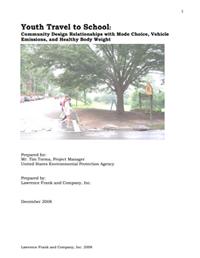
EPA commissioned Youth Travel to School: Community Design Relationships with Mode Choice, Vehicle Emissions, and Healthy Body Weight (2008) to examine if and how various factors influence school travel for a large sample of youths from Atlanta, Georgia, aged 5 through 18. The study reviewed household travel patterns, land use, and air emissions data to assess the impacts of community form and school location on how students get to school.
The study’s primary aims were to:
- Investigate factors influencing student travel mode choices for school trips.
- Examine the implications of those choices on vehicle emissions.
- Investigate the influence of urban form variables around the home, school, and route on body mass index (BMI) for a subset of children aged 16 to 18.
The study examined how neighborhood design around the home, along the route to school, and surrounding the school site shape travel choices. Data on parents’ travel patterns, their preferences for walkable or automobile-oriented environments, and their perceptions of safety for walking and biking within their community provided an important set of control variables.
Summary of Findings
Short distances are crucial to encouraging walking to school. The probability of walking drops off quickly and dramatically as the distance to school increases: from about 25 percent of all school trips at the shortest distances (under 0.1 miles) to less than 5 percent for trips over 1 mile.
Neighborhood design is more important for short school trips and for younger children. Neighborhood design factors are more significant predictors for shorter school trips (0 to 1.5 miles) than for longer trips. Short trips are most likely to be walking trips, so urban form could make more of a difference in the choice of whether to walk.
Mode choice changes as students age. The probability of walking increases between the ages of 5 and 8, then holds relatively constant until age 12. It increases again between ages 12 and 16 and dips at age 16.
Neighborhood design influences emissions. Neighborhood design characteristics, including higher residential densities, more sidewalks, and interconnected streets, consistently relate with more walking trips to school and fewer emissions (including carbon dioxide). The study shows clear transportation and environmental benefits from changes in physical infrastructure and the surrounding built environment.
School quality influences school travel. When parents perceive their neighborhood school to be of higher quality, children are more likely to walk to it. This is particularly true for short trips and younger children, who are most likely to be attending neighborhood schools.
Urban form might affect obesity. The available data sample might not be representative of the larger target population. Although the relationship was significant, study findings suggest a larger sample is necessary for a more thorough evaluation of urban form’s impact on childhood obesity.
EPA would like to thank the expert panel who reviewed this study and commented on the methodology: Tracy E. McMillan, University of Texas at Austin; Alex Strashny, U.S. Department of Transportation, National Highway Traffic Safety Administration; Gabe Rousseau, U.S. DOT, Federal Highway Administration; Jeff Vincent, Center for Cities & Schools; Chad Bailey, EPA Office of Air and Radiation.
Top of Page
You will need Adobe Reader to view some of the files on this page. See EPA’s About PDF page to learn more.